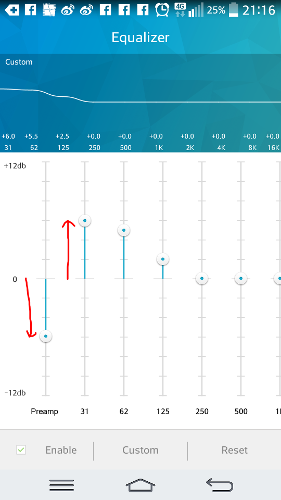tbritton
500+ Head-Fier
Top Ten reasons why the "don't EQ so that you hear the recording the way it was intended" purity argument is a bit weak.
- Most recordings are mixed on special reference speakers. No headphones can sound like these special speakers, nor would you want them to sound that way. No audio engineer listens to music at home over reference speakers. They just aren't fun at all for music enjoyment. Whether you are talking near-field monitors or otherwise, reference speakers don't sound as good as good home speaker systems do. Additionally, no headphones sound like reference speakers, though some people prefer to mix with headphones so they can bring their work with them and they don't have to rely upon a treated room to work in, as the environment portion of the equation is controlled by the nature of them using headphones. If they mix with headphones, listening to the music using the mixing engineer's headphones will not matter so much because of what the mastering engineer will do after the tracks are all completed.
- Most recordings are mixed a second time by a mastering engineer to make the tracks more similar in sound across the entire album. This also is done using special reference speakers in most cases. I've never met a mastering engineer who used headphones for mastering purposes, but perhaps there are some out there. I'd be surprised.
- Most recordings are mastered to sound good across a wide variety of reproduction systems - from uber-high-end audio systems to uber-low-end portable radio speakers. Compromises are made in order to make the recording work across such a wide range of output systems.The mastering engineers will check their work with headphones, but they will check their work on many other systems as well.
- Your output system is not the same output system as the mastering engineer's, nor is your room the same soundproofed and treated room, nor is your humidity the same, nor are your ears the same. The mastering engineer's job is to make the end product sound uniformly good even though your equipment and environment and ears are not the same as his.
- All playback equipment is made to add color that enhances the listening experience to make it more lively and exciting than reference speakers can provide. A "clean" signal does not imply one without coloration - that simply means no harmonic distortions and other negative qualities are introduced into the signal chain. Every time a capacitor and resistor meet, coloration is introduced. This coloration is balanced through various means to produce a favorable "sound signature" to the equipment. Additionally, the best speakers and headphones have "sound signatures" that are considered by listeners to be well balanced and that produce good enhancements to the audio.
- Not all coloration is a perfect match for every person's ears or tastes, no matter how close that system's coloration may come to achieving that goal. Nor is it going to be perfect for every program source, mix, mastering and style of music. One way of fine-tuning the inherent coloration of the sound system to achieve subjective "perfection" is called "EQ".
- Though there can be some corrective tonal balance changes performed via EQ that favorably affect the majority of music played on a given system to a person's ears, there will always be some recordings that have mastering approaches which leave something to be desired to that listener.
- We are allowed to be in disagreement with a recording's mastering engineer, because they admittedly have committed sacrifices with the music's EQ in order to make the album sound uniform as a whole as well as to make it work across such a wide range of output systems and devices. This effort often detracts from individual tracks and reverses the intentions of the original mix-down engineer. We can often intuit these deficiencies that came about due to the mastering effort, and compensate for them to hear the music in a more lively manner, returning the recording to the original intention somewhat by using EQ. However, using EQ on a song-by-song basis is cumbersome. Still, it can make certain tracks come back to life.
- Headphones have the distinction of giving you a controlled environment in which to listen, which makes them ideal candidates for seeking idealized sound reproduction. However, that fact of being a controlled environment in itself introduces some limitations that manufacturers have to overcome by controlling the sound signature of each headphone in an effort to compensate for those limitations. Closed-headphones have entirely different characteristics from open-headphones and, likewise, from in-ear headphones. So, the natures of these inherently differing sound signatures will pose different considerations and challenges to the manufacturers. Each tries to balance their decisions to make the best sounding end result for the widest number of customers and musical styles, and so compromises are made similar to those made by mastering engineers. (The same truth applies to speaker manufacturers, but they have an even wider range of issues to take into account.)
- We are allowed to be in disagreement with the headphone's engineers, because they have admittedly committed sacrifices with the music's EQ in order to make their headphones sound uniform as a whole across a range of musical styles, human ear Helix, antihelix, lobule, crest of helix, external auditory meatus, eardrum, auditory ossicles, oval window, cochlea, semicircular canal, eighth nerve and eustachian tube shapes, and personal tastes. Thus, we are allowed to apply a bit of EQ to bring the sound closer to our personal tastes, as the manufacturer knows they could not have possibly achieved such a lofty aim as to be everything to everybody.
I rest my case.
Terry


























